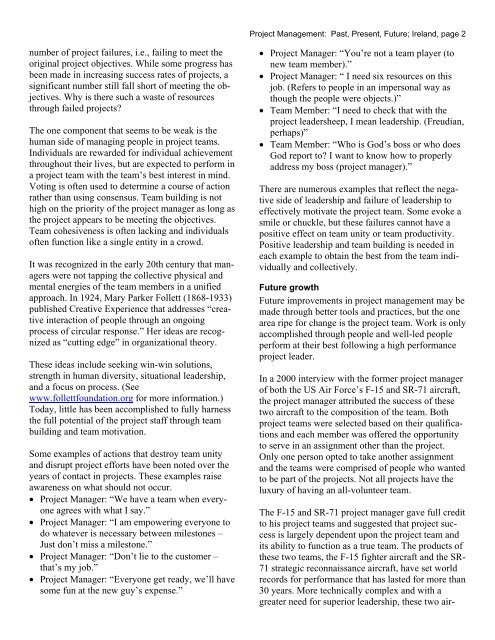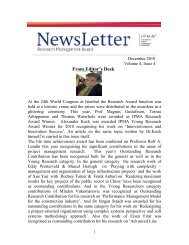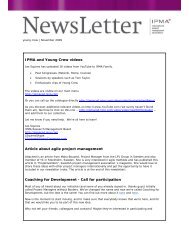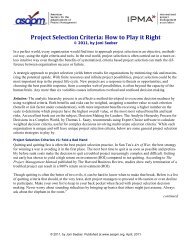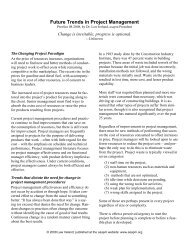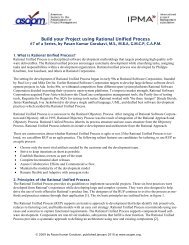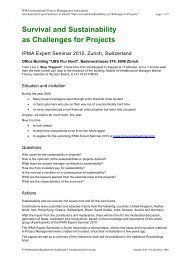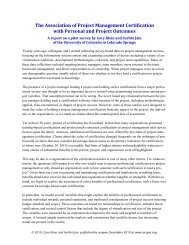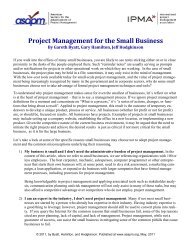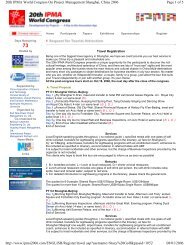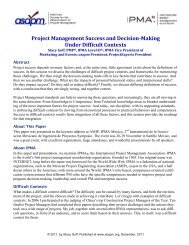Project Management: Past, Present, Future - asapm
Project Management: Past, Present, Future - asapm
Project Management: Past, Present, Future - asapm
Create successful ePaper yourself
Turn your PDF publications into a flip-book with our unique Google optimized e-Paper software.
number of project failures, i.e., failing to meet the<br />
original project objectives. While some progress has<br />
been made in increasing success rates of projects, a<br />
significant number still fall short of meeting the objectives.<br />
Why is there such a waste of resources<br />
through failed projects?<br />
The one component that seems to be weak is the<br />
human side of managing people in project teams.<br />
Individuals are rewarded for individual achievement<br />
throughout their lives, but are expected to perform in<br />
a project team with the team’s best interest in mind.<br />
Voting is often used to determine a course of action<br />
rather than using consensus. Team building is not<br />
high on the priority of the project manager as long as<br />
the project appears to be meeting the objectives.<br />
Team cohesiveness is often lacking and individuals<br />
often function like a single entity in a crowd.<br />
It was recognized in the early 20th century that managers<br />
were not tapping the collective physical and<br />
mental energies of the team members in a unified<br />
approach. In 1924, Mary Parker Follett (1868-1933)<br />
published Creative Experience that addresses “creative<br />
interaction of people through an ongoing<br />
process of circular response.” Her ideas are recognized<br />
as “cutting edge” in organizational theory.<br />
These ideas include seeking win-win solutions,<br />
strength in human diversity, situational leadership,<br />
and a focus on process. (See<br />
www.follettfoundation.org for more information.)<br />
Today, little has been accomplished to fully harness<br />
the full potential of the project staff through team<br />
building and team motivation.<br />
Some examples of actions that destroy team unity<br />
and disrupt project efforts have been noted over the<br />
years of contact in projects. These examples raise<br />
awareness on what should not occur.<br />
• <strong>Project</strong> Manager: “We have a team when everyone<br />
agrees with what I say.”<br />
• <strong>Project</strong> Manager: “I am empowering everyone to<br />
do whatever is necessary between milestones –<br />
Just don’t miss a milestone.”<br />
• <strong>Project</strong> Manager: “Don’t lie to the customer –<br />
that’s my job.”<br />
• <strong>Project</strong> Manager: “Everyone get ready, we’ll have<br />
some fun at the new guy’s expense.”<br />
<strong>Project</strong> <strong>Management</strong>: <strong>Past</strong>, <strong>Present</strong>, <strong>Future</strong>; Ireland, page 2<br />
• <strong>Project</strong> Manager: “You’re not a team player (to<br />
new team member).”<br />
• <strong>Project</strong> Manager: “ I need six resources on this<br />
job. (Refers to people in an impersonal way as<br />
though the people were objects.)”<br />
• Team Member: “I need to check that with the<br />
project leadersheep, I mean leadership. (Freudian,<br />
perhaps)”<br />
• Team Member: “Who is God’s boss or who does<br />
God report to? I want to know how to properly<br />
address my boss (project manager).”<br />
There are numerous examples that reflect the negative<br />
side of leadership and failure of leadership to<br />
effectively motivate the project team. Some evoke a<br />
smile or chuckle, but these failures cannot have a<br />
positive effect on team unity or team productivity.<br />
Positive leadership and team building is needed in<br />
each example to obtain the best from the team individually<br />
and collectively.<br />
<strong>Future</strong> growth<br />
<strong>Future</strong> improvements in project management may be<br />
made through better tools and practices, but the one<br />
area ripe for change is the project team. Work is only<br />
accomplished through people and well-led people<br />
perform at their best following a high performance<br />
project leader.<br />
In a 2000 interview with the former project manager<br />
of both the US Air Force’s F-15 and SR-71 aircraft,<br />
the project manager attributed the success of these<br />
two aircraft to the composition of the team. Both<br />
project teams were selected based on their qualifications<br />
and each member was offered the opportunity<br />
to serve in an assignment other than the project.<br />
Only one person opted to take another assignment<br />
and the teams were comprised of people who wanted<br />
to be part of the projects. Not all projects have the<br />
luxury of having an all-volunteer team.<br />
The F-15 and SR-71 project manager gave full credit<br />
to his project teams and suggested that project success<br />
is largely dependent upon the project team and<br />
its ability to function as a true team. The products of<br />
these two teams, the F-15 fighter aircraft and the SR-<br />
71 strategic reconnaissance aircraft, have set world<br />
records for performance that has lasted for more than<br />
30 years. More technically complex and with a<br />
greater need for superior leadership, these two air-


